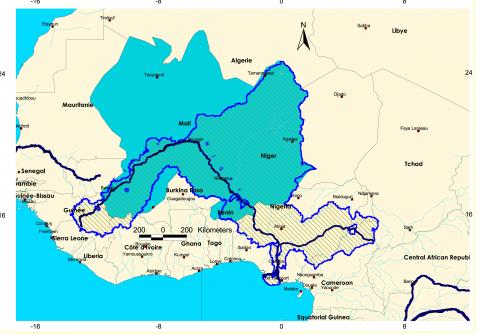Approval Date
August 2018
Project Duration
5 years (60 Months: 2018-2023)
Countries of operations
Algeria, Benin, Burkina, Cameroon, Chad, Guinea, Côte d'Ivoire, Mali, Mauritania, Niger and Nigeria
Financial & Technical Partners
GEF Agencies : UNDP, UNEP
Other executing partners
- Niger Basin Authority (NBA)
- Observatory of the Sahara and Sahel (OSS)
- UNESCO-IHP
- UNIDO (with NBA)
Project Beneficiaries
Local, national and regional institutions responsible for the management of groundwater and surface water in the 11 countries concerned: Algeria, Benin, Burkina Faso, Cameroon, Ivory Coast, Guinea, Mali, Mauritania, Niger, Nigeria and Chad.
Objective
The objective of the project is to improve knowledge-based management, governance and resource conservation of the Niger River Basin and the Iullemeden-Taoudéni/Tanezrouft Aquifers (ITTAS), to support IWRM for the benefit of communities and the resilience of ecosystems. In other terms, to implement conjunctive management of surface and groundwaters through knowledge-based management and governance of the Niger Basin and the Iullemeden-Taoudeni/Tanezrouft Aquifer System (ITTAS) leading to improved IWRM for the benefit of communities and the resilience of ecosystems.
This project will contribute to the attainment of a number SDGs namely SDG 6 on clean water and sanitation and in particular target 6.5 related to integrated water resources management at all levels, including through transboundary cooperation (and the related indicators) as well as SDGs related to the improvement of the livelihoods of local communities that are targeted through the project activities.
The geographic scope of this study and GEF intervention covers the whole area as covered by Niger River Basin and the ITTAS, two transboundary basins that are crucial for millions of people living in rural areas who still rely heavily on agriculture for their livelihoods.
Project Status
Project being started
Project main components
- Component 1 - Promoting conjunctive management of ground and surface waters. The main aim of this component is to complete the TDA for the entire ITTAS and develop the ITTAS SAP as well.
- Component 2 - Sharing responsibilities and benefits with local communities, civil society in conserving basin resources, including groundwater. (To implement a wide range of community-based projects aimed at addressing many of the key issues and challenges originally identified as well as those conjunctive management pilots anticipated to be identified.
- Component 3 - Strengthening industries’ environmental/social responsibility capacities. (Encouraging industry to reduce pollution through the adoption of best practices and new technology).
- Component 4 - Capacity building and stakeholders involvement in Niger River ecosystem based management. (A cross-cutting component which aims at supporting the required building of capacity to ensure that national policies and institutions are in place towards ecosystem-based management of the Niger River basin).
Expected Outcomes
- Outcome 1 - IWRM supported by a sound understanding of ground water resources and their linkages with surface water systems
- Outcome 2 - Niger Basin Users Associations and National NGOs engaged in basin resources management and conservation for better control of flood/drought/pollution, reduction of pressure on land, forest and biodiversity while improving living conditions of households
- Outcome 3 - Systematic and integrated approach of industrial competitiveness and environmental/social responsibility through Environmentally Sound Technology (TEST) to reduce wastewater discharges and pollution loads in the Niger River introduced and demonstrated
- Outcome 4 - National Policies and Institutions, Civil Society Platforms support Niger River Ecosystem based management
The surface water resources of the Niger River basin are linked to major groundwater systems, which do not share the same geographical location although there are major overlaps. The Iullemeden and Taoudeni/Tanezrouft Aquifer Systems overlain on the Niger River Basin. The Taoudeni/Tanezrouft Aquifer lies largely outside the limits of the Niger River Basin despite being linked to both the Iullemeden Aquifer and the Niger River system.

